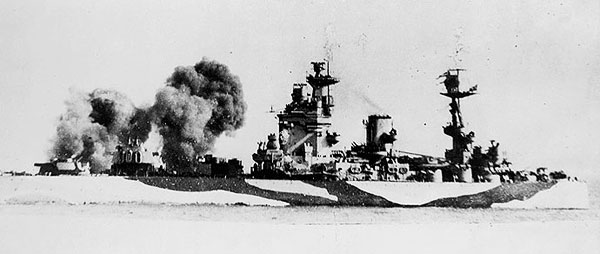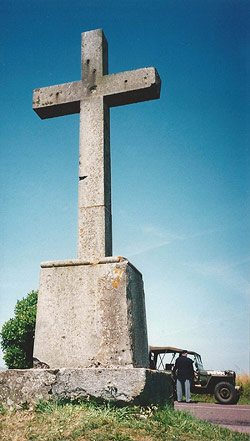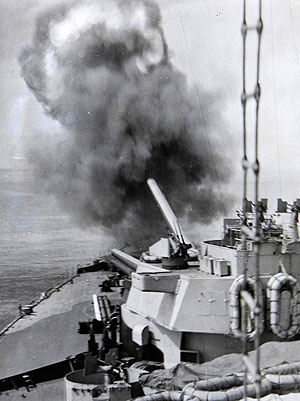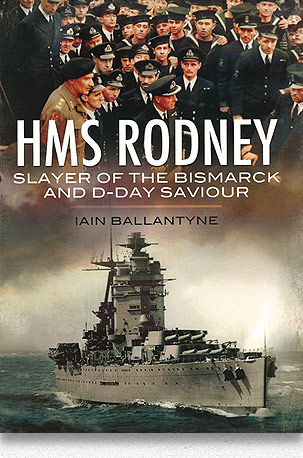Adapted Extract from ‘HMS Rodney’

Big Guns were the Crack of Doom for the Germans in Normandy
Adapted book extract from ‘HMS Rodney’
The story of Royal Navy battleships during the fight for Normandy in the summer of 1944 did not end on D-Day itself. For, until the troops were able to breakout decisively and advance beyond range of the big guns their services would be required. And they could, on occasion, prove decisive.
Just ask the commander of an elite, battle-hardened Waffen SS formation blooded in action against the Russians of the Eastern Front and switched to Normandy, only to be hammered by HMS Rodney’s 16-inch shells.
General Paul Hausser, commander of the II SS Panzer Corps, was forced at the end of June to tell his higher commanders a ‘murderous fire from naval guns’ together with concentrated fire of British Army artillery had ‘destroyed the bulk of our attacking force in its assembly area.’ He continued: ‘The few tanks that did manage to go forward were easily stopped by the British anti-tank guns.
Hausser and the other German commanders were unaware Britain’s top secret code-breaking centre had provided key information. Bletchley Park’s deep and repeated penetration of wireless and signals traffic handed the Allies a decisive edge.
Yet, even without decrypting the wireless transmissions and signals, via something called the Traffic Analysis method Allied commanders were able to identify both their origin and which units they were from. Decrypts, combined with Traffic Analysis, explain why the Allies often knew the exact intentions of German commanders. They were able to strike with naval gunfire and artillery while tanks and panzer grenadiers were gathering for an attack.
Carpet-bombing by the Allied air forces often inflicted destruction on empty woods and fields. More responsive naval guns and Army artillery could be directed with far greater precision against tank hides and bunkers.
Nevertheless, the psychological impact of aerial bombing combined with the guns of the Navy and Army inflicted Hell on earth upon the enemy. Some German troops were literally driven insane and even resorted to shooting themselves, rather than endure further bombardment. In one episode where Bletchley’s code-breakers played a vital role, some 50 out of 127 German tanks massing for an attack were wiped out.

The 16-inch guns of HMS Rodney unleash hell against German troops and tanks in Normandy. Photo: Morris Collection.
The UK’s official naval historian, Captain Stephen Roskill, writing in 1960, chose to highlight HMS Rodney’s remarkable fire mission against German troops and tanks on 30 June 1944. At the time of writing, Roskill was not able to do more than hint at the remarkable advantages the Allies enjoyed, for Bletchley’s work was still being kept under wraps. ‘… the Rodney astonished the Germans by planting her 16-inch shells squarely on tanks which were massing for a counter-attack 17 miles inland from the “Gold” beaches,’ Roskill explained. ‘Again and again did such ships earn the warm appreciation of the soldiers, and the frequent lamentations of the German army commanders also testify to the effectiveness of the naval gunfire.’
HMS Rodney’s men were immensely pleased to hear their ship’s bombardments shattered enemy morale. One German soldier allegedly said as he surrendered: ‘We’ll fight you. We’ll fight your tanks, but those naval guns are too much.’
The Germans were not as incapable of hitting back against the ships, as some might imagine due to the state of their withered air and naval forces. German efforts at sea and in the air post-D-Day have perhaps been under represented in various accounts of the campaign. HMS Rodney was a prime target and in the early hours of 6 July, she was informed that human torpedoes and midget submarines were trying to infiltrate Allied anchorages off the beachhead. The warning prompted her to raise steam with all speed. The battleship’s Midshipman Tony Robinson wrote in his journal that the ship was at ‘panic stations’. There had already been several false alarms: ‘Someone saw bubbles appearing from the ship’s side. Suspicious of a limpet mine being placed on the hull, the alarm was sounded and a small charge dropped over the side. Investigation proved that someone had left a pump from a bathroom sump running, and after clearing the water it was pumping air out!’

An illustration showing a German ‘Neger’ V3 human torpedo of the kind that was used to try and sink HMS Rodney off Normandy. Image: Dennis Andrews.
Unlike the British variant, which used a detachable warhead, the German V3 ‘Neger’ human torpedo was in fact composed of two torpedoes, one slung under the other. The pilot rode the top torpedo, firing the one underneath when he felt it was properly lined up on target.
HMS Rodney was such a prize because not only would removing the British battleship relieve pressure on German divisions slowly being ground into the dust, it would also hand the Nazis a much-needed propaganda victory.
As a counter-measure, small boats were sent out to circle the ship, their crews tasked with dropping explosive charges at regular intervals to deter frogmen and human torpedo operators. Motor Launches (ML) joined in, also dropping charges.
A Polish Navy ML captured a V3 and its pilot. According to Midshipman Roger Morris, under interrogation the German frogman ‘confessed that there were 50 of them operating from… a small town just beyond our eastern flank.’ Morris reported in his Midshipman’s journal: ‘At 19.00 approximately we [Rodney] opened fire… the target being numerous factory buildings believed to be those used for operating the enemy torpedoes. Sixteen rounds were fired and repeated hits were scored, this being followed by another shoot at 19.15, only four rounds being fired, as the target was observed to have been destroyed…’
Some of Rodney’s sailors received an opportunity to go ashore and gain a closer look at the battlefield. One excursion, at the invitation of the Guards Armoured Brigade, saw Rodney’s men boarding trucks to head for Tilly. It was notorious for heavy fighting, with severe casualties on both sides. The Germans lost the village and re-took it several times before the British seized and held it for good.
Even so, as Midshipman Robinson reported, it was still a dangerous place to even be near: ‘We were stopped about a mile outside by an M.P. [Military Policeman] He told us that the Germans were shelling the road and village and no traffic was allowed down it. At this stage we were about a mile from the front line – we passed a notice saying, “Achtung – Jerry – Dust brings shells! Be Careful”. So we had to turn around.’
The next stop was Bayeux and on the way, during a picnic lunch by the side of the road, Midshipman Robinson and others from Rodney picked poppies to take back to the ship. They intended pressing them as mementos of their battlefield tour. Before the trucks hit the road again, one of the senior ratings even managed to harvest a good crop of strawberries.

The Cross of Calvary at Hill 112, a scene of bitter fighting between the British and troops of the Waffen SS in the summer of 1944. The cross remains pockmarked with bullet holes. HMS Rodney’s guns more than once fired in support of the British forces locked in combat with the Germans on Hill 112.
Photo: Iain Ballantyne.
While they were away Rodney bombarded a crossroads north of Caen, near Hill 112, laying down forty-nine 16-inch shells, hoping to persuade the Germans it was not worth holding. Later, there was a second fire mission, against enemy troops and tanks. Like air power, Naval Gunfire Support, and Rodney’s guns in particular, formed the great equalizer in the Normandy campaign. Commander Michael Chichester, aboard bombardment flagship HMS Belfast, described Rodney’s 16-inch guns as ‘striking terror into the hearts of those Germans unfortunate enough to be at the receiving end of one of her salvos.’
The British Army saluted Rodney’s interventions. Such was the devastating effect of 16-inch guns on the battlefield, one infantry battalion commander referring to it as ‘a great solace’, describing how his Brigade Headquarters would contact Rodney via radio during night fighting and ask for a ‘Victory Salvo’. There was a roar out to sea and a flash of light, the shells ripping overhead to crash down on a hapless enemy formation.
The Rodney’s ability to intervene many miles inland, literally wiping out fortifications – neutralizing whole battalions of soldiers at a time and hurling battle tanks about, or smashing them to pieces – surely saved hundreds, if not thousands, of lives on the Allied side.

The 16-inch guns of HMS Rodney pummel German troops during the summer of 1944. Photo: Morris Collection.
The fact that a bombardment by Rodney could churn up an entire wood or fortified village, where panzers or 88mm anti-tank gun batteries lay in wait, was a huge boost to the morale of Allied attackers. It undoubtedly meant many infantrymen and tank crews lived to fight another day. Such overwhelming firepower filled the Germans with impotent fury and fear, explaining why the remnants of the Luftwaffe and the Kriegsmarine made repeated efforts to sink Rodney.
Midshipman Robinson wrote in his journal on 9 July 1944: ‘About 02.00 they made a very determined attack on the anchorage. Several [enemy aircraft] flew over us, one dropping a stick of five bombs, which fell about three hundred yards off our starboard bow, shaking the ship. A large number of flares were dropped down in Sword [Beach] area but none near us. I loathe the flares – one feels so awfully naked as they drift about overhead and there is nothing we can do about them. It was reported that there were one hundred and fifty enemy planes over us altogether – more than we’ve ever had before in a single night.’
Come the morning, HMS Rodney was still firing, still hurting the enemy’s panzers and troops. Germans vainly burrowing their way into the earth to escape the effects of her 16-inch shells were still loudly cursing her. When the enemy heard big naval guns boom, they knew it was Rodney. They knew it was the crack of doom.
On 5 July the millionth Allied soldier had gone ashore, so ending Operation Neptune, the amphibious assault phase of Overlord. The Allied armies had more than enough artillery now and with Caen on the brink of liberation the campaign would move into a new phase. The Allies would break out into the flat, wide open country and charge towards Paris. The warfare would become fast moving, eating up miles of countryside every day, rather than just consuming hundreds of lives for thousands of yards. The battle would soon be beyond the reach of even Rodney’s 16-inch guns.

General Bernard Montgomery talking to HMS Rodney’s men about the importance of their gunnery to success in the D-Day breakout. Photo: Morris Collection.
‘We’ll fight you. We’ll fight your tanks, but those naval guns are too much.’
A German officer who had experienced HMS Rodney’s devastating bombardments.
‘A stick of five bombs fell about three hundred yards off our starboard bow, shaking the ship.’
Midshipman Tony Robinson about the night up to 150 German bombers tried to sink HMS Rodney.
To read the full story of HMS Rodney’s part in supporting Allied troops fighting in Normandy, and also about the legendary battlewagon’s many other battles, buy the paperback edition of ‘HMS Rodney’
Pen & Sword Maritime
Paperback
288 pages
ISBN: 9781848848702
Published: 23 May 2012

